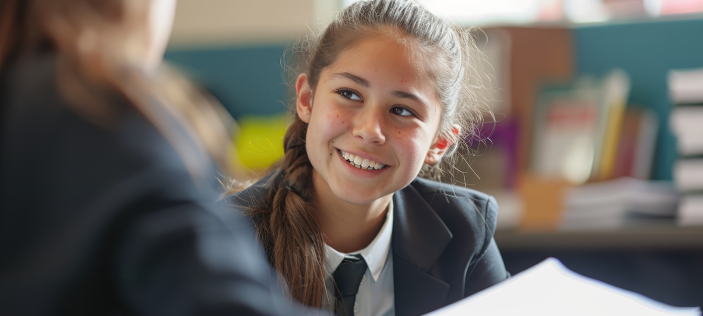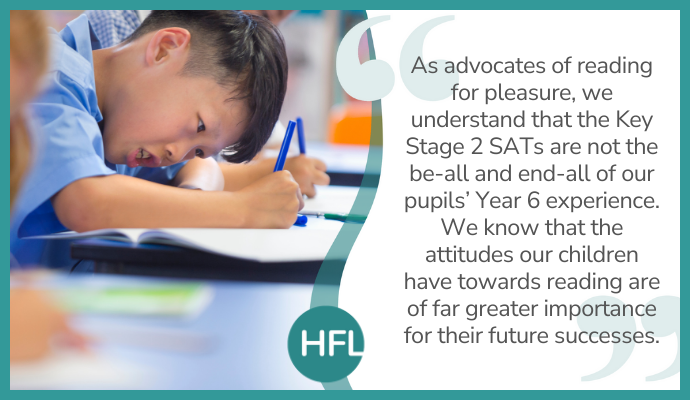
The topic of the key stage 2 reading SATs has often created division amongst primary teaching professionals. I am sure, like me, many of you reading this will have been involved in some animated discussions with parents, teachers and most definitely the children themselves! It’s no surprise that in 2019, this poem (written by an unknown teacher-poet) went viral, with schools across the country still adding it to their newsletters today:
“SATs don't hear your laughter, or see you've come this far,
SATs are just a tiny glimpse of who you really are.
So, sitting at your table, with a pencil and your test,
Remember SATs aren't who you are, remember you're the best.”
As advocates of reading for pleasure, we understand that the key stage 2 SATs are not the be-all and end-all of our pupils’ year 6 experience. We know that the attitudes our children have towards reading are of far greater importance for their future successes. We do however want our year 6s to feel confident, prepared and (in an ideal world) eager to put their skills to the test! (In one of our schools, our Lockdown 2019 Year 6s were disappointed that the SATs were cancelled - they even voted to have a mock-up week!)
The final stretch
With very few teaching days left, and some bank holidays thrown in for good measure, this blog is intended to give you some last-minute, practical pointers for the big week, all before the children embark on a vastly different journey of secondary school transitions and leavers events!
| Date | Activity |
| Tuesday 9th May 2023 | English grammar, punctuation, and spelling papers 1 and 2 |
| Wednesday 10th May 2023 | English reading |
Let’s find the balance between ensuring our pupils are test-ready, whilst maintaining that all important, lifelong love of reading.
Plenty of practice
Whatever the model, practice remains key. Continue to immerse your pupils in a wide range of inspiring, challenging texts that will shape their life, and not just their ability to pass the test. It is not too late to have them flourishing with fluency! Stay with the impactful reading fluency strategies that we know build confidence, increase stamina and perfect accuracy.
Keeping this level of “normality” is not just going to benefit their reading, but it will also help to maintain structure and routine during what many will find a challenging period.
Perfect pitch (…or not?)
We know how important it is to provide the correct level of challenge for our Year 6 readers. They will hopefully have spent their primary years filling up on a rich reading diet. Now, with not long left to go, why not give them a more accessible text, pitched slightly lower than they have been used to as of late? This will help them to develop their answers, whilst giving them a well needed confidence boost, going into the tests with an “I can” attitude. On the morning of the test itself, warm them up by sharing a quick, simple, and inspiring picture book or poem that may be familiar to them.
Collaborate!
The tests themselves may be intended to be completed alone but what benefit does onerous, repeated testing in silence really have on our children? The answer is very little. What is more important on the lead up to the tests, is providing a chance for your children to learn from one another. Have them tackling texts together, answering authentic questions in small groups and pairs instead.
What is your ‘impression of’ 3-mark questions?
The key stage 2 reading SATs 3-mark questions can be daunting and, often, pupils will avoid even attempting them. Ask pupils in pairs to sort SATs questions according to how many marks they think each question is worth. Then, they can work together to construct the perfect answer. Provide them with a speaking frame so that they can practice orally at first, before attempting to write it out.
In the text it says …
This suggests that the character is…
It also says… which tells me that…
SATs speak
Sneak ‘test talk’ into your daily class chat and embed it across the curriculum. This way, you are getting your pupils used to the style of questioning and language that they will come across in the tests. Use it often enough and it will become second nature! You may find it beneficial to use the reading domain question stems, which can be downloaded here.
Gamification!
Make use of online resources and quizzes like Mentimeter, Kahoot, Quizlet, Miro and Rolloma to reduce test anxiety and instead create a positive sense of competition, interaction and motivation. Work in teams to collect vocabulary, share synonyms or answer timed questions. These tools are also useful for relaxed, discrete revision of grammar, punctuation, and spelling.
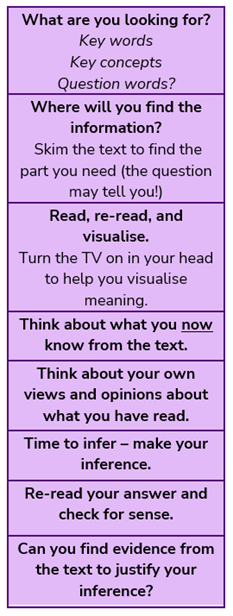
Develop the quality of inferential response
Inference is the most tested reading domain and the skill our pupils find the trickiest (and often the one we find most challenging to teach). When teaching inference, the modelling of your thought process is vital. Tools such as skills ladders and concept maps can support children’s thinking when making inferences - and can be used collaboratively, too!
Consider reading some of our back catalogue for a forensic analysis of past papers: Preparing for the 2022 KS2 Reading SATs: unpicking challenge in non-fiction texts
Visual literacy
Get children answering SATs style questions (with an inference focus!) using varied visuals and media. Remind the children how powerful visualising is for aiding understanding and how we can apply this to reading. Generating powerful imagery will help keep them focused and make some of the images within the text more memorable. The more they practise this skill, the more likely it is to stick.
Useful visual literacy resources for inference:
Once Upon a Picture- The Inference Collection
How to Read a Painting – National Gallery
Short films like Oktapodi or Alma
Visual literacy is also a great tool for writing development! See our Visual Literacy Narrative Unit for Y5/6.
A simple summarising skill!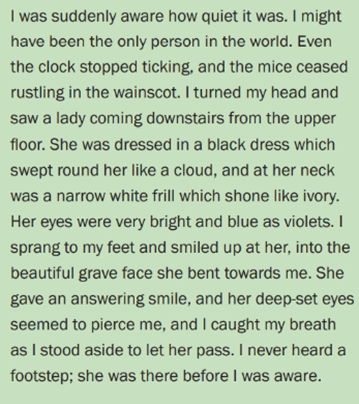
Show pupils how simply recording one key word or phrase, next to each paragraph, can help them to keep track of where information is in longer texts. This active reading skill will support them when they need to refer to the text.
For example, in this extract, taken from the 2022 Key Stage 2 SATs Reading Paper, pupils might quickly record ‘lady appeared’ to help then pinpoint this important development in the story.
Pronouns – who did what to who and when?
In his book ‘Reading Reconsidered,’ Doug Lemov refers to referent questions. These questions ask what a word (often a pronoun) refers to. It is these questions that pupils often trip up on. Look at this extract from ‘Music Box’ taken from the 2019 Key Stage 2 SATs Reading Paper for example:
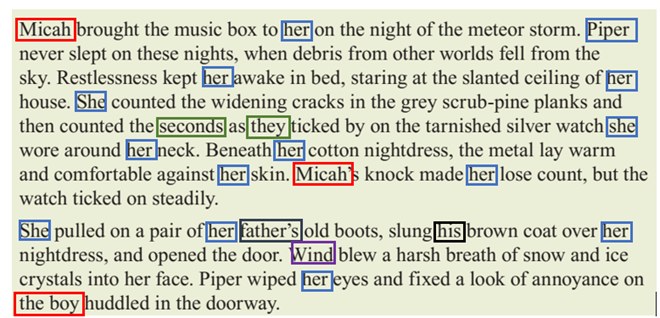
In just the first paragraphs alone, pupils must tackle with the reference to three characters (not to mention the personification of seconds and wind), and the pronouns she, her, they, his and finally, ‘the boy.’ You can imagine the confusion! Help pupils by making them aware of pronouns and the purpose of them. Get them tackling one sentence at a time, distinguishing between characters and events using the summarising skills mentioned above, to pinpoint key words and events.
“What does that word mean?”
- Does it have a capital letter? Do not panic; it is only a name!
- The definition of a challenging word or phrase could be right in front of you. Teach children to read it in context, paying attention to the words around it. Sometimes, these words will help them bring the sentence to life or give them some extra clues.
- Look for prefixes, suffixes and other small units of meaning in the word to aid understanding.
- Use knowledge of grammar and syntax (e.g., that must be a verb, or that word is describing the noun).
SATs simulation
Although it is vital not to aimlessly over-test in the lead up to the real thing, it is certainly helpful to give pupils a good idea of what test day will look like - a dress rehearsal if you will. Overdoing it with the practice papers can cause undue stress, but giving pupils an idea of the seating arrangements, what equipment they will need, brief discussions around the administration guidance, and presentation/handwriting legibility will certainly help to put some minds at ease.
“Write your answer in full sentences!”
With the SATs tests being time sensitive, this is not always the best advice. It is useful for the pupils to know exactly what the expectations are for different questions. Review the instructions from previous test papers to be reminded of question-and-answer expectations and help pupils get straight to the point.
Know your readers
Find time over the testing period to check in with your pupils on a 1:1 or small group basis. What kind of readers are they? Perhaps they’re super speedy readers that will have no problems finishing the test in time but will miss key information (or sometimes entire pages). They may need reminding to re-read and re-check for accuracy. Your slower readers may require a few tips to help them push through at a faster speed. A simple ‘check-in’ may put some anxious minds at ease.
All aboard!
This would also be a fantastic opportunity to remind parents about maintaining positive mental wellbeing during what many can find a stressful time.
Third Space Learning have some great activity suggestions for supporting our young minds.
“Fit your own oxygen mask before assisting others.”
Something that the inspirational Dr Dan Nicholls reminded us of recently. It is easy to say, but not-so-easy to execute, particularly during the testing period. Remember, there is nothing to be gained from last minute cramming or panic teaching. What’s done is done, and no doubt, what you have done is prepare a class of confident children who love to read.
It is this lifelong skill that will stay with them into their next journey of education and beyond.
Further reading
Reflections from analysis of the 2019 KS2 reading SATs: part 1
Reflections from analysis of the 2019 KS2 reading SATs: part 2
Reflections from analysis of the 2019 KS2 reading SATs: part 3
Reflections from analysis of the 2019 KS2 reading SATs: part 4






